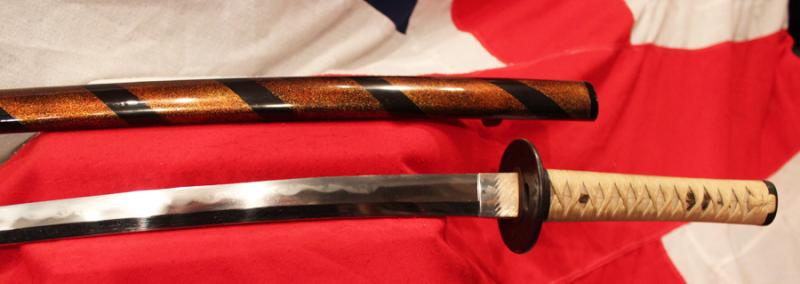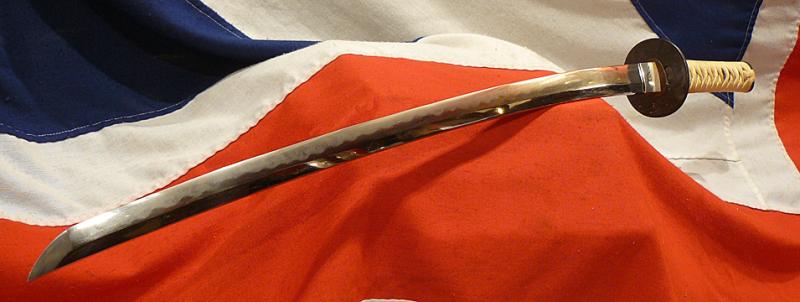Ancient, Most Beautiful & Singularly Stunning 15th Century Samurai Sword’. With Stylised 'Tiger's Tail' Saya of Stripes of Black Urushi Lacquer and Gold Nashiji, With Takeda Kenhanabishi ‘Takeda Shingen The 'Tiger of Kai', Clan Mon in Gold on Shaku
Very fine tachi mei signed blade, around 535 years old, possibly considerably older, with superb quality mounts bearing the Takeda kenhanabishi Clan mon {hanabishi with ken}. Fully traditionally made blade with an amazingly active hamon and running grain hada. A powerful blade, of considerable size and status
This is a wonderful ancient original samurai sword worthy of any museum grade collection or display. It would be equally at home in a private residence or a presidential boardroom. Amongst a collection of fine art or as a stand-alone statement piece..
Along with the clan crest {mon} of Takeda, to denote it was owned by a Takeda clan samurai, possibly a daimyo, {or for a seieibushi samurai, they were the elite, and the highest ranking of the samurai}, and worn formerly, as a tachi.
It is mounted in a 'stylized' Takeda Shingen's 'Tiger Tail' saya, a design which is often the most dramatic symbol of a samurai’s highest status, such as for a daimyo lord. There is a famous original print of Takeda Shingen in the gallery, with his tachi, mounted within a tiger's tail skin covered saya. This katana's saya was styled upon that form of saya of Takeda, but, in gold and urushi lacquer, and not in tiger skin.
Takeda Shingen (武田 信玄, December 1, 1521 – May 13, 1573) was daimyo lord of Kai Province during the Sengoku period of Japan. Known as the "Tiger of Kai", he was one of the most powerful daimyo of the late Sengoku period, and credited with exceptional military prestige. Shingen was based in a poor area with little arable land and no access to the sea, but he became one of Japan's leading daimyo. His skills are highly esteemed and on par with Mōri Motonari.
Circa 1480, the blade is signed tachi mei but, due to great age the signature is near illegible. An ancient tachi blade that in the Koto era was changed by its fittings to be worn as a katana. Imperial white silk wrap ito, and most elegant fittings patinated copper, shakudo, with pure gold overlaid mon of the Ken-Hanabishi clan kamon without ken, originally used by the Takeda clan such as the famous Takeda Shingen.
The tsuba is iron ground with gold inlays around figures. Used on guards since the Momoyama period although the technique existed since much earlier periods.
The menuki under the imperial white silk binding are in the form of arrows with strap cutting heads, outlined in gold. The blade is superb, showing a stunningly beautiful and incredibly active hamon, and in full traditional polish, with just natural age wear and marks.
The sword is signed tachi mei, but no longer translatable due to age. The saya is nishiji and black urushi contrasting spiral lacquer. The fuchi-gashira have gold mon on a very finely decorated ground. The dots are usually arranged in straight lines or in lines parallel to the edge of the piece being decorated, but sometimes in more elaborate patterns appearing to be none uniform.
In the ancient period the tachi was used primarily on horseback, where it was able to be drawn efficiently for cutting down enemy foot soldiers. On the ground it was still an effective weapon, but somewhat awkward to use. The uchigatana was the predecessor to the katana as the battle-blade of feudal Japan's bushi (warrior class), and as it evolved into the later design, the two were often differentiated from each other only by how they were worn and by the fittings for the blades.
It was during the Mongol invasions that it was shown there were some weaknesses in the tachi sword which led to the development of the Katana.
It is said that kenhanabishi was first used as a family crest by the Kai-Takeda clan, the hanabishi, which has a standard design, and was used as the official family crest of the Takeda family.
A complimentary display stand, damask silk storage or transit bag, handling gloves and micro-fibre cloth will accompany this fine piece. Plus, a fully comprehensive certificate of authenticity as usual
Code: 19729










